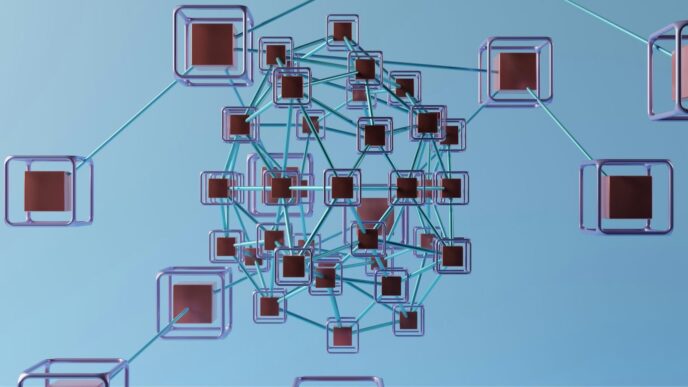Edge computing is changing how we handle data by bringing processing closer to where it is generated. This shift offers many benefits, but it also raises important questions about security. In this article, we will explore the key aspects of edge computing security, including its challenges, threats, and best practices for keeping data safe in a decentralized network environment.
Key Takeaways
- Edge computing brings data processing closer to the source, which improves speed but increases security risks.
- Cyber attacks on edge devices can lead to serious data breaches and privacy issues.
- Regular updates and strong passwords are essential for keeping edge devices secure.
- AI and machine learning can help detect threats and respond quickly to security issues.
- Collaboration between businesses and security experts is important for creating a safe edge computing environment.
Understanding Edge Computing Security
Defining Edge Computing
Edge computing is a way to process data closer to where it is created, rather than sending it all to a central server. This helps in reducing delays and improving speed. In simple terms, it means doing more computing at the edge of the network.
Importance of Security in Edge Computing
Security is very important in edge computing because:
- Data is often processed in many different locations.
- Devices can be more vulnerable to attacks.
- Protecting sensitive information is crucial.
Challenges in Edge Computing Security
There are several challenges that come with securing edge computing:
- Limited resources on edge devices can make security hard.
- Diverse environments mean different security needs.
- Keeping software updated can be difficult.
Edge computing is changing how we handle data, but it also brings new security risks that need attention.
In summary, understanding edge computing security is essential for protecting data and ensuring smooth operations. As we move forward, we must address these challenges to keep our systems safe.
| Challenge | Description |
|---|---|
| Limited Resources | Edge devices may not have enough power for strong security. |
| Diverse Environments | Different devices and locations require unique security measures. |
| Software Updates | Keeping all devices updated can be a big task. |
Key Threats to Edge Computing Security
Cyber Attacks on Edge Devices
Edge devices are often vulnerable to cyber attacks due to their decentralized nature. These attacks can include:
- Malware infections that compromise device functionality.
- DDoS (Distributed Denial of Service) attacks that overwhelm devices, making them unusable.
- Unauthorized access where hackers gain control over devices.
Data Breaches and Privacy Concerns
Data breaches can lead to serious privacy issues. Some common causes include:
- Weak passwords that are easy to guess.
- Unencrypted data that can be intercepted.
- Poorly secured networks that allow unauthorized access.
Physical Security Risks
Physical security is just as important as digital security. Risks include:
- Theft of devices that store sensitive data.
- Damage to devices from environmental factors.
- Unauthorized physical access to edge locations.
Protecting edge devices is crucial because they often handle sensitive information. A single breach can lead to significant consequences for both individuals and organizations.
Best Practices for Securing Edge Devices
Implementing Strong Authentication
To keep edge devices safe, it’s crucial to use strong authentication methods. This means using passwords that are hard to guess and changing them regularly. Here are some tips:
- Use multi-factor authentication (MFA) whenever possible.
- Avoid using default passwords that come with devices.
- Regularly update passwords to enhance security.
Regular Software Updates and Patching
Keeping software up to date is essential for security. Regular updates help fix vulnerabilities that hackers might exploit. Here’s what to do:
- Set devices to automatically update when new software is available.
- Regularly check for updates if automatic updates are not an option.
- Patch any known vulnerabilities as soon as possible.
Encryption and Data Protection
Encrypting data is a key step in protecting sensitive information. Data encryption makes it unreadable to anyone who doesn’t have the right key. Consider these strategies:
- Use encryption for data both at rest and in transit.
- Implement secure storage solutions to protect data.
- Regularly review and update encryption methods to stay ahead of threats.
Protecting edge devices is not just about technology; it’s about creating a culture of security awareness.
By following these best practices, organizations can significantly reduce the risks associated with edge computing. Strong authentication, regular updates, and effective encryption are vital components of a secure edge environment.
Role of AI and Machine Learning in Edge Computing Security
AI-Driven Threat Detection
Artificial Intelligence (AI) plays a crucial role in identifying potential threats in edge computing environments. AI systems can analyze vast amounts of data quickly, spotting unusual patterns that may indicate a security issue. This helps in:
- Detecting anomalies in real-time
- Reducing false positives
- Enhancing response times to threats
Machine Learning for Anomaly Detection
Machine Learning (ML) algorithms learn from data and improve over time. They can be trained to recognize normal behavior in edge devices and flag anything unusual. Key benefits include:
- Continuous learning from new data
- Adapting to evolving threats
- Minimizing manual intervention
Automating Security Responses
With AI and ML, security responses can be automated, making systems more efficient. This means that when a threat is detected, the system can take immediate action without waiting for human input. This automation can include:
- Blocking suspicious activities
- Alerting security teams
- Initiating recovery processes
In a world where cyber threats are constantly evolving, leveraging AI and ML is essential for maintaining robust security in edge computing environments.
By integrating these technologies, organizations can better protect their data and devices, ensuring a safer decentralized network.
Network Security in Edge Computing
Securing Communication Channels
To protect data in edge computing, it’s crucial to secure communication channels. This can be done by:
- Using encryption to keep data safe while it travels.
- Implementing VPNs (Virtual Private Networks) to create secure connections.
- Regularly updating protocols to defend against new threats.
Firewalls and Intrusion Detection Systems
Firewalls and intrusion detection systems (IDS) are essential for monitoring and controlling network traffic. They help in:
- Blocking unauthorized access to devices.
- Detecting suspicious activities in real-time.
- Alerting administrators about potential threats.
Network Segmentation Strategies
Dividing a network into smaller parts can enhance security. Here are some strategies:
- Isolate sensitive data from less secure areas.
- Use different security measures for each segment.
- Regularly review and adjust segments based on risk assessments.
Effective network security is not just about technology; it’s about creating a culture of awareness and vigilance.
In summary, securing edge computing networks involves a mix of strong communication protocols, protective systems, and smart segmentation. By focusing on these areas, organizations can better protect their data and devices.
Data Protection Strategies for Edge Computing
Data Encryption Techniques
Data encryption is crucial for keeping information safe in edge computing. It ensures that even if data is intercepted, it remains unreadable without the correct key. Using strong encryption methods can protect sensitive data from unauthorized access. Here are some common encryption techniques:
- AES (Advanced Encryption Standard): Widely used for its security and speed.
- RSA (Rivest-Shamir-Adleman): Often used for secure data transmission.
- TLS (Transport Layer Security): Protects data during transfer over networks.
Secure Data Storage Solutions
Storing data securely is just as important as encrypting it. Here are some strategies to ensure data is safe:
- Use cloud storage with strong security measures.
- Implement access controls to limit who can view or edit data.
- Regularly back up data to prevent loss in case of a breach.
Data Masking and Tokenization
Data masking and tokenization are techniques used to protect sensitive information. They help in reducing the risk of data exposure. Here’s how they work:
- Data Masking: Hides original data with modified content.
- Tokenization: Replaces sensitive data with unique identifiers (tokens) that retain essential information without compromising security.
Protecting data in edge computing is not just about technology; it’s about creating a culture of security awareness. Everyone must play a role in safeguarding information.
Compliance and Regulatory Considerations
Understanding Relevant Regulations
In the world of edge computing, regulations play a crucial role. Organizations must be aware of laws like GDPR, HIPAA, and CCPA that govern data protection. These laws ensure that personal information is handled properly and that users’ rights are respected.
Ensuring Compliance in Edge Environments
To stay compliant, companies should:
- Regularly review their data handling practices.
- Train employees on compliance requirements.
- Use tools that help monitor compliance status.
Impact of Non-Compliance
Failing to comply with regulations can lead to serious consequences, including:
- Heavy fines that can hurt finances.
- Damage to reputation, making customers lose trust.
- Legal actions that can disrupt business operations.
Compliance is not just a checkbox; it’s a commitment to protecting users and their data.
By understanding and following these regulations, businesses can create a safer environment for their data and build trust with their customers.
| Regulation | Key Focus Areas |
|---|---|
| GDPR | Data protection, user rights |
| HIPAA | Health information privacy |
| CCPA | Consumer privacy rights |
Case Studies of Edge Computing Security
Successful Implementations
Several companies have successfully implemented edge computing security measures. Here are a few examples:
- Company A: Used strong encryption to protect sensitive data.
- Company B: Implemented regular software updates to keep devices secure.
- Company C: Developed a robust authentication system to prevent unauthorized access.
Lessons Learned from Security Breaches
Security breaches can teach valuable lessons. Some key takeaways include:
- Always monitor devices for unusual activity.
- Ensure all software is up-to-date.
- Train employees on security best practices.
Innovative Security Solutions
New solutions are emerging to enhance edge computing security. Some notable innovations are:
- AI-driven threat detection systems that identify risks in real-time.
- Machine learning algorithms that learn from past incidents to improve security.
- Advanced encryption methods that protect data even in decentralized environments.
In the world of edge computing, staying ahead of threats is crucial. Companies must adapt and innovate to protect their data effectively.
Highlight: this page discusses foodrgb’s innovative natural sweeteners designed for food manufacturers, focusing on healthier bakery products. it highlights the role of artificial intelligence in enhancing customer experiences and personalizing journeys, as well as its transformative impact on digital marketing. the content emphasizes the convergence of ai and decentralization, showcasing insights from the token 2049 summit.
Future Trends in Edge Computing Security
Emerging Technologies
As technology evolves, new tools and methods are being developed to enhance security in edge computing. Some of these include:
- Blockchain for secure transactions
- Quantum computing for advanced encryption
- 5G networks for faster and more secure connections
Predictions for Security Challenges
With the rise of edge computing, we can expect several challenges to emerge, such as:
- Increased cyber attacks targeting edge devices
- More complex data privacy issues
- Greater risks from physical security breaches
Preparing for Future Threats
Organizations need to be proactive in their approach to security. Here are some steps they can take:
- Conduct regular risk assessments
- Invest in training for employees on security best practices
- Collaborate with security vendors for the latest solutions
The future of edge computing security will require constant adaptation and vigilance to stay ahead of potential threats. Staying informed and prepared is key to protecting valuable data.
Building a Robust Edge Computing Security Framework

Risk Assessment and Management
To create a strong security framework, it’s essential to start with a risk assessment. This helps identify potential threats and vulnerabilities. Here are some steps to follow:
- Identify assets that need protection.
- Evaluate potential risks to those assets.
- Determine the impact of each risk.
Developing Security Policies
Once risks are assessed, the next step is to develop clear security policies. These policies should include:
- Guidelines for data access and sharing.
- Procedures for reporting security incidents.
- Rules for using personal devices at work.
Continuous Monitoring and Improvement
Security is not a one-time task; it requires ongoing effort. Continuous monitoring helps detect issues early. Here are some ways to ensure improvement:
- Regularly review security policies.
- Update software and systems frequently.
- Train staff on security best practices.
A strong security framework is essential for protecting data in a decentralized network environment. It ensures that all devices and data are safe from potential threats.
| Security Aspect | Importance Level |
|---|---|
| Risk Assessment | High |
| Policy Development | Medium |
| Continuous Monitoring | High |
Collaboration and Partnerships in Edge Computing Security
Industry Collaborations
Collaboration among different industries is crucial for enhancing security measures in edge computing. By working together, companies can share knowledge and resources to tackle common security challenges. Here are some key benefits of industry collaborations:
- Shared Knowledge: Companies can learn from each other’s experiences and best practices.
- Resource Pooling: Organizations can combine their resources to develop better security solutions.
- Standardization: Collaborations can lead to the creation of industry standards that improve security protocols.
Public-Private Partnerships
Public-private partnerships play a significant role in strengthening edge computing security. These partnerships can help in:
- Funding Research: Joint efforts can lead to more funding for research in security technologies.
- Policy Development: Collaborations can help shape policies that protect data in edge environments.
- Crisis Management: Working together can improve responses to security incidents.
Role of Security Vendors
Security vendors are essential in the edge computing landscape. They provide tools and services that help organizations secure their networks. Key roles include:
- Providing Solutions: Vendors offer software and hardware solutions tailored for edge security.
- Training and Support: They provide training to help organizations understand and implement security measures.
- Continuous Updates: Vendors ensure that their products are regularly updated to combat new threats.
In a world where data breaches are common, collaboration is key to building a secure edge computing environment. By working together, organizations can better protect their data and systems from potential threats.
Conclusion
In summary, securing data in edge computing is crucial as more devices connect to the internet. With data spread out across many locations, it’s important to have strong protections in place. This means using good security practices, like encrypting information and keeping software updated. Everyone, from companies to regular users, must work together to keep data safe. By being aware of the risks and taking steps to protect information, we can enjoy the benefits of edge computing while keeping our data secure.
Frequently Asked Questions
What is edge computing?
Edge computing is a way to process data closer to where it’s created instead of sending it all to a central place. This helps devices work faster and more efficiently.
Why is security important in edge computing?
Security is crucial in edge computing because many devices are connected to the internet. If these devices are not secure, they can be attacked, and sensitive information can be stolen.
What are some common threats to edge computing security?
Common threats include cyber attacks, where hackers try to gain access to devices, data breaches where private information is leaked, and physical risks like someone stealing a device.
How can I protect edge devices?
You can protect edge devices by using strong passwords, keeping software up to date, and encrypting data to keep it safe.
What role does AI play in edge computing security?
AI helps improve security by spotting unusual activities and threats automatically. It can also help respond to security issues faster.
How do we keep data safe in edge computing?
To keep data safe, you can use encryption, which scrambles the data so only authorized users can read it. Also, storing data securely is important.
What regulations should I know about edge computing?
It’s important to understand laws that protect personal data. Following these rules helps ensure that you are handling data safely.
What are the future trends in edge computing security?
Future trends may include new technologies that enhance security, predictions about new threats, and ways to prepare for these challenges.













